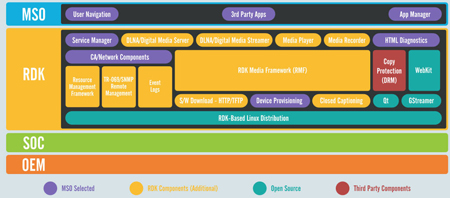Broadcasters Can Join Hybrid IP Future Via Cable
BURLINGTON, MASSACHUSSETTS--While the debate about the end game for the proposed Comcast/Time Warner Cable merger rages on, the two companies have been working behind the scenes for at least a year on a common platform for supporting two-way interactivity and video on demand services. About nine months ago, the two operators—along with several others in the U.S. and Canada—entered into a multi-year, joint venture called the RDK Management LLC, whose mission has been developing special set top boxes with integrated software that supports both IP and QAM signals in the same hybrid box.
Bob Harrison, Solution Architect at a systems integration firm called Symphony Teleca, participated in the design and implementation of the Reference Design Kit (RDK) used by these operators. The RDK represents an integrated bundle that can be accessed by operators in need of a software stack for set-top devices. The field-tested and integrated system runs on QAM, IP and Hybrid devices.
Thus far about 1.7 million of these new RDK-based boxes have been deployed in the U.S. (with more to come this year) that provide consumers with both traditional cable services, and IP and cloud based services (such as Cloud DVR, gaming, social media integration and advanced, targeted advertising). (The combined Comcast/TWC will have some 30 million subscribers, if the merger is approved by the government).

Bob Harrison, a Solution Architect at Symphony Teleca, helped design and implement the Reference Design Kit used by operators like Comcast and Time Warner Cable.
“Comcast’s XFINITY platform was achieved via a common software architecture on set top boxes, using the RDK we developed with them,” Harrison said, adding that his Burlington, Mass.-based company (formerly Triple Play Integration) was bought by Symphony Teleca in 2011 and provides infrastructure designs solutions for cable operators and their vendors within North America to enable video and voice services.
“We (along with silicon-on-chip vendors Intel and Broadcom, and set top OEMs Arris, Cisco and Pace) have been working with cable operators for the past four years in developing this platform. It’s now been adopted by Comcast, TWC, Liberty Global and Rogers Cable [Canada],” he said.
The RDK software components are available for use on devices used by operators with an RDK license agreement. RDK vendors can license the software and contribute to the RDK stack. The RDK software is available to all RDK licensees in a shared source manner.
Harrison’s design tools support: direct video distribution over a DRM protected H.264 / IP mechanism; application development using HTML5; integration with Adobe's Primetime advanced TV publishing and monetization platform for programmers; and multiple screen integration of set top and consumer's mobile devices.
Harrison will present a technical paper at the upcoming NAB Show entitled “RDK Demystified: How Broadcasters Can Leverage Cable's Reference Design Kit Launch,” where he will try to convince broadcasters that they too can get involved in the video over IP future.

The RDK represents an integrated bundle that can be accessed by operators in need of a software stack for set-top devices. The field-tested and integrated system runs on QAM, IP and Hybrid devices. “This RDK has heretofore been focused on the cable TV market, but I want to let people know that this RDK can be very beneficial to terrestrial broadcasters as well,” Harrison said. “Those that have content, both over the air and carried by these operators, can leverage the application enablement within these platforms. There are certain opportunities that are pretty compelling that MSOs can take advantage of using broadcasters’ content.”
He described how broadcasters would leverage those RDK set top boxes in subscribers’ homes to support a hybrid delivery of content.
“So, in the past we had a QAM-based RF channel lineup and VOD services that would be brought into consumers’ homes through the cable headends,” Harrison said. “Now, with these hybrid RDK set top boxes, there is QAM delivery as well as pure IP delivery.”
One of the things that will be attractive to broadcasters is that they’ll be able to continue to provide broadcast content through the traditional QAM cable lineup, but they can also accommodate interactivity through HTML5 on the IP channel. So, one can imagine developing an HTML5 application with video as sourced from the QAM side and all of the data and interactivity in the return path is all done with the IP channel.
“Broadcasters will have an OTT capability on boxes that are already installed in subscribers’ homes,” Harrison said. “It’s what they have been looking for to join the IP revolution.”
He believes the industry will begin to offer a whole host of new services (cloud-based gaming, etc.) that involves collaborative play and two-way interactive in real time. With video being delivered over IP, we’ll see cable operators provide Netflix, Amazon Primetime, Hulu Plus, etc. as well as a la carte programming, if subscriber so choose.
“We need an all-IP future because there is so much more inherent flexibility,” Harrison said. “Cable companies’ 750 MHz can be allocated in so many different ways. In the past they put a single channel on 6 Mhz. Now, with compression and bit-rate adjusting, they can put up to 20 channels in that same 6 MHz bandwidth.”
“When IP delivered video reaches the quality level of today’s television services, IP is the natural solution,” he said. “We’re approaching the point where the quality of service (and experience) of IPTV delivery by cable operators is comparable to what they have been able to do with digital QAM. When that is at true parity, then MSOs can say, ‘I don’t need to have a traditional lineup of programs anymore. I can use my bandwidth more effectively to provide on-demand services exclusively to my subscribers rather than a traditional channel lineup.’”
Programming available via a la carte viewing: that’s what consumers want to hear.
“We finally have the adequate network infrastructure (bandwidth) and capabilities on handheld devices to deliver on this promise of Interactive TV and IP-based on-demand delivery, when the consumer wants to watch it, that we have been talking about for so many years,” Harrison said. “Moore’s Law has caught up to the visions of the past. And that’s good for everybody.”
Get the TV Tech Newsletter
The professional video industry's #1 source for news, trends and product and tech information. Sign up below.
